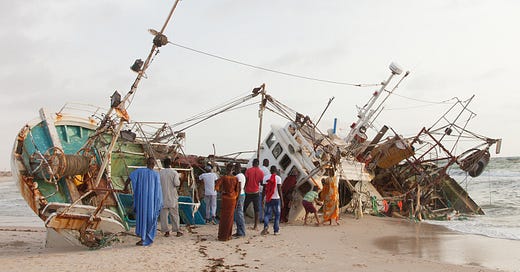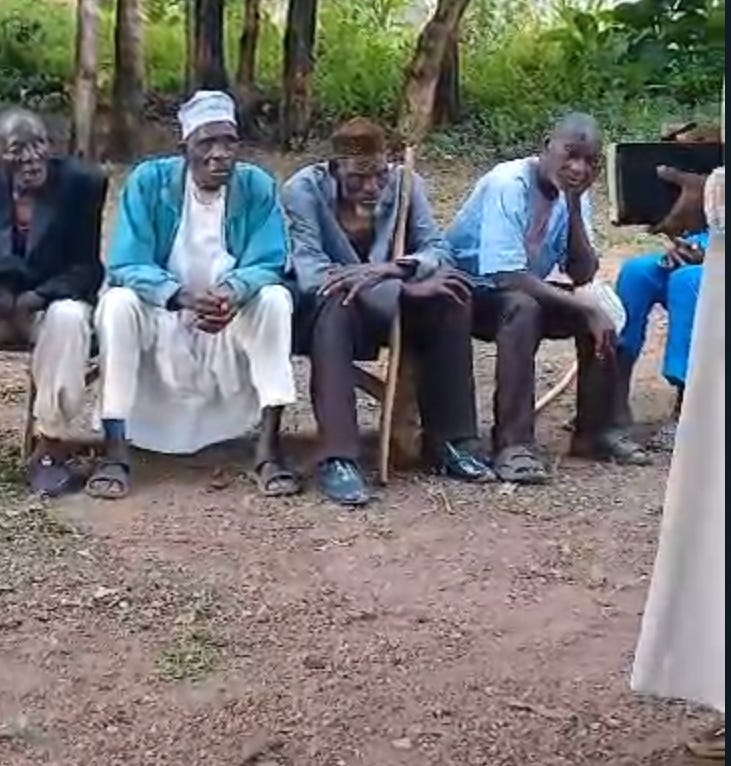It is easy to count everyone in the photograph. The idea might be to reckon with their reckonings—how each body, for instance, presents itself in relation to the ship at the moment it is pictured. And it might be easy, as well, to notice the stance of the ship, how its body keels aground as if in drunken stupor. Whichever way we choose to look at it, and whatever exercise we attempt in response, the photograph is also one of the sea as it reaches towards the sand, a fact as true as a sky that knows no boundary.
— Emmanuel Iduma
“As we travelled further north, I thought a lot about the Mediterranean Sea.”
I came across this ship in 2014, a few months into a long, slow journey I was making from Nigeria to Italy. It was a Japanese fishing trawler, and it had washed up on the shores of Nouakchott, on the west coast of Africa, having developed engine trouble.
It was almost sunset – the cinematic hour. The sky was warm and the scene was just so inviting. But I knew this golden moment was transitory, as I had been coming to the wreck again and again at different times, noticing how the light changed with each visit, and how many other people were visiting it. It took me a while to figure out what I wanted to do with it.
The shot became part of my project, called The Act of Recovery. I was looking at the complex narrative of migration, across Africa and Europe. We are used to seeing shipwrecks on the shores of Europe, as overcrowded vessels transporting African migrants north get washed up like carcasses. But this shot seemed to invert that notion. Here was an outlier, one that had travelled the other way, heading south. It wasn’t yet another displaced African body. That made it feel powerful.
There are ship graveyards not far from this spot. I had seen photographs of them by the Tunisian artist Zineb Sedira. When I first encountered this ship, I thought about her shots, which are all about the repurposing of western waste. But unlike Sedira’s graveyard ships, this vessel had not been stripped and looted. It was still functional. All its elements, including the radar, were still in place.
I used a documentary style but, as with all the images in the project, it did involve a certain amount of staging. I had seen children climbing on the ship for a better look, while adults stood back, observing from a distance. I didn’t want to dictate the scene too heavily, so I just turned up with a group of people who hadn’t been told what to wear and let them approach the ship. Their clothes reflect all the colours you tend to see at that time of day. My friend Mohammed – on the far left – wore a blue fabric that seems to extend the sea.
I spent the first part of my project travelling through the continent with 10 African artists, film-makers and photographers, all crammed into a Ford Econoline van. Travelling by road across Africa is quite difficult. Some countries are more easily reached from outside the continent, as opposed to within. This journey was much more than a traditional road trip, though. We did public presentations and ran workshops wherever we stopped. I got to know local film-makers and would screen their work alongside my own at outdoor cinemas for anyone to see.
As we travelled further north, I thought a lot about the Mediterranean Sea. It ought to be a means of exchange, but for many it has become an impenetrable boundary.
— Dawit L. Petros
About Dawit L. Petros
Dawit L. Petros is a visual artist, researcher and educator. His works have been recognized with awards including a Terra Foundation Research Fellow, the Paul De Hueck and Norman Walford Career Achievement Award in Art Photography, the Duke and Duchess of York Prize in Photography, an Art Matters Fellowship, Canada Council for the Arts Production Grants, and Artist Residencies at The Studio Museum in Harlem, The McColl Center for Visual Art, Addis Ababa Photo Fest and an Independent Study Fellowship at the Whitney Museum of American Art. More details of his work, exhibition history, and publications can be found on his website.
EDITORIAL NOTE: This statement was first published in The Guardian, as “Dawit L Petros's best photograph: a shipwrecked Japanese trawler,” following an interview by Karin Andreasson. Courtesy of Guardian News & Media Ltd under the Open License Terms.
LAST WEEK
—“Youssef,” by Mohamed Hozyen
When I saw Youssef I thought he was an attractive person. I stopped and stepped back and started talking with him, listening to his story. Every Sunday he goes to the seaside of the cornice and has a very long walk enjoying this side of the city as he is an old man now and has nothing to do and he loves to walk so much.
—“Cousins and Kisses,” by Sabo Kpade, in KINDRED
“Manasseh is dead!” — the words come to me with a finality, the full measure of which I do not comprehend. When we spoke on the phone just last week, he sounded like himself. Today, he is no more. I would accept it if I knew the weight of his demise. At the moment, I am afraid, I do not know. I know I will never see my cousin again. I could not look at the videos and photos sent by Simbi, his younger sister, until now.
SUPPORT TENDER PHOTO
This is the 90th edition of this publication, which also read on web (best for viewing images), and via the Substack iOS/Android apps.
Every Wednesday I feature one photograph and the photographer who took it: you’d read a short caption from me, and a statement from the photographer. Every Friday, I publish a series of commentaries in response to photographs previously featured on the newsletter. The ongoing series is KINDRED. My hope is to engage with early to mid-career African photographers, and to create a platform in which photographers lead the cataloguing and criticism of their work.
Photographers can now submit their work for consideration.
Thank you for reading. If this newsletter was shared with you, consider subscribing, or forward to a friend. Please whitelist the newsletter to ensure you never miss it.







I am not sure, why it feels like the vessel is a dead thing, lying in state at a wake keeping. But I am sure that one of the best gifts to give a dead thing is time. Even if it's time spent just looking.